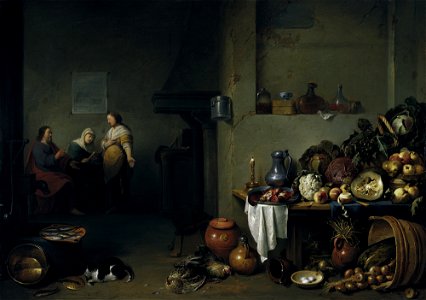In his painting "christ with mary and martha", pieter de bloot combined the religious scene with a kitchen still life in the foreground. This type of painting was already outdated when the painting was created in 1637 and goes back to compositions by pieter aertsen (1507/08–1575) from the middle of the 16th century. The fact that the sacred depiction seems to have been pushed into the background is not an expression of waning interest in faith and its message. On the contrary: this judgmental arrangement is a symbol of the dualism of human life. People are usually more concerned with their physical well-being, symbolized by the still life of magnificent fruit, vegetables, etc. , than with their spiritual well-being and thus also their faith in god. It is therefore important to overcome the temptation of everyday pleasures and to save one's soul by devoting oneself to the true values of life. Mary and martha, through their different characters, show the two ways of serving god: martha with the book in her hand stands for the "vita contemplativa", i. E. Study and meditation. Mary with her apron and her sleeves rolled up energetically represents the "vita activa", the path of good deeds. The sensual aspect of the lavish arrangement of delicacies on the kitchen table also alludes to sexuality: the cat eating the fish, birds, eggs and onions were considered erotic symbols. Object Type: painting. Genre: inverted still-life. Date: 1637. Dimensions: height: 47 cm (18.5 in); width: 66 cm (25.9 in). Medium: oil on panel. Collection: Liechtenstein Museum. Bloot, Pieter de - Christus bei Maria und Martha, 1637
Loading...
